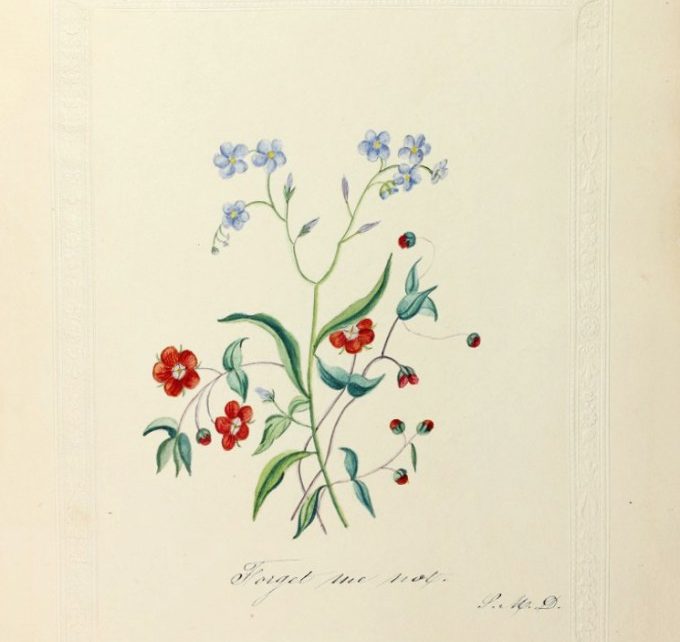A rose is a rose is a revolution.
In his thrice-revised and expanded autobiographies, Frederick Douglass, born Frederick Bailey, recounts changing his surname multiple times to cover his fugitive trail. When the time came to settle on a permanent name, he invited the man in whose home was taking refuge — a free black man devoted to helping fugitive slaves — to choose for him, as a token of gratitude. His host suggested Douglas — the self-possessed Highlander hero of one of the era’s greatest literary blockbusters, Sir Walter Scott’s poem The Lady of the Lake. In his retelling, Frederick Douglass brushes past the additional s, with the vague intimation that he added it for distinction.
But there is another probable possibility for the peculiar spelling. Here was an orphan with no sense of roots, an aching ambivalence about his parentage, and a longing for communal belonging. And here was the grown man of genius retelling his own story of becoming, aware — like all persons of genius — that a larger mythos of colossal cultural significance hangs upon their private myth.
Forget me not by Sarah Mapps Douglass
Since the dawn of the abolition movement, women had played an active and ardent role in fundraising, organizing, and public advocacy — women who risked ostracism, or worse, for exercising the agency of stepping outside the narrow confines of the domestic sphere allotted them and into the cosmos of political activism. One of the movement’s leading women was the young Philadelphian Sarah Mapps Douglass (September 9, 1806–September 8, 1882), who at only twenty-five had organized a major fundraising campaign for the primary journalistic instrument of abolition — William Lloyd Garrison’s paper The Liberator, on the pages of which Frederick Douglass found and trained his own literary voice.
The daughter of two active abolitionists, Sarah was born into one of America’s most prominent black families and raised in the Quaker tradition — her grandfather, Cyrus, had been a slave to a local Quaker baker who liberated him and taught him the baking trade; Cyrus soon opened his own successful bakery, which allowed him to fund and operate a school for black children from his home, later becoming a founding member of the pioneering Free African Society seventy-five years before Abraham Lincoln staked his credo and his life on the Emancipation Proclamation.
Rose painting and poem by Sarah Mapps Douglass (Library Company of Philadelphia. Available as a print and as a face mask.)
Sarah was nursed on a love of literature and a love of nature, immersed in art and music, and lavished with painting lessons in a bubble of her privilege — provisional and relative, as all privilege is. Growing up amid the intellectual ferment of abolition, she grasped the terrors of slavery only abstractly, as an idea and not a felt reality, not fully imagining how other children who looked like her lived very different lives, how people who looked like her parents died gruesome deaths. Then, as a young woman, she performed one of those rare, triumphal acts that signify true maturity and grandeur of spirit: changing one’s mind as it expands to take in a broader perspective and publicly acknowledging one’s previously limited views.
Unsigned rose and scroll, likely by Sarah Mapps Douglass, from Amy Matilda Cassey’s friendship album. (Library Company of Philadelphia. Available as a print, a face mask, and stationery cards.)
In 1832, Sarah Mapps Douglass recounted her awakening to the urgency of abolition in a rousing speech at a gathering of the Female Literary Society of Philadelphia, of which she was a leader — the first specialty library for African-American women, literate and illiterate, free and enslaved, devoted to “the cultivation of intellectual powers” as the highest tribute to the sanctity of human nature. She told the women gathered before her:
An English writer has said, ‘We must feel deeply before we can act rightly; from that absorbing, heart-rendering compassion for ourselves springs a deeper sympathy for others, and from a sense of our weakness and our own upbraidings arises a disposition to be indulgent, to forbear, to forgive.’ This is my experience. One short year ago, how different were my feelings on the subject of slavery! It is true, the wail of the captive sometimes came to my ear in the midst of my happiness, and caused my heart to bleed for his wrongs; but, alas! the impression was as evanescent as the early cloud and morning dew. I had formed a little world of my own, and cared not to move beyond its precincts. But how was the scene changed when I beheld the oppressor lurking on the border of my own peaceful home! I saw his iron hand stretched forth to seize me as his prey, and the cause of the slave became my own.
The following year, in a friendship album compiled by her Philadelphian friend and fellow activist Amy Matilda Cassey, Sarah Mapps Douglass fused her twin loves of literature and nature with her artistic acumen in a series of consummate flowers she painted alongside selections from poems she transcribed in her lovely longhand.
Flowers by Sarah Mapps Douglass, with transcribed anonymous poem. (Library Company of Philadelphia. Available as a print, a face mask, and stationery cards.)
No marvel woman should love flowers, they bear
So much of the fanciful similitude
To her own history; like herself repaying
With such sweet interest all the cherishing
That calls their beauty or their sweetness forth;
And like her too — dying beneath neglect.
Cassey would maintain and expand the album, now found in the collection of The Library Company of Philadelphia, for two decades, drawing contributions — poetry, prose, paintings, sketches — by some of the era’s most prominent abolitionists, including Garrison, Lucy Stone, and Frederick Douglass himself. The flowers Sarah Mapps Douglass painted in it are considered the first surviving artworks signed by an African-American woman.
A token of love, from me, to thee by Sarah Mapps Douglass (Available as a print and as a face mask.)
To a similar album complied by one of her pupils, Mary Anne Dickerson, Sarah Mapps Douglass contributed a single, splendid painting of fuchsia — Fuchsia triphylla, so named in the last years of the 17th century by a French monk and botanist, after a German botanist and herbalist born in the first year of the 16th century — an uncommonly beautiful and fragrant flowering plant uprooted from its native habitat in Central and South America, so that an uncommonly gifted young woman of uprooted roots could tend to it and paint it in her native antebellum Philadelphia — a tender reminder that by whatever ugly and unchosen forces we might come into this world, into the dispensation of chance contouring our lives, there is always the choice to consecrate those lives and this world with the willful brush of beauty.
Fuchsia by Sarah Mapps Douglass (Library Company of Philadelphia. Available as a print and as a face mask.)
Complement with Frederick Douglass on how photography, improbably invented seven years after Sarah painted her flowers, helped the cause of social justice by bridging the real and the ideal, then revisit these stunning 18th-century natural history paintings of exotic, endangered, and extinct animals by another trailblazing Sarah of an earlier era and this pictorial encyclopedia of medicinal plants a young Scottish mother illustrated another generation earlier to bail her husband out of debtor’s prison.
donating = loving
For 15 years, I have been spending hundreds of hours and thousands of dollars each month to keep Brain Pickings going. It has remained free and ad-free and alive thanks to patronage from readers. I have no staff, no interns, no assistant — a thoroughly one-woman labor of love that is also my life and my livelihood. If this labor makes your life more livable in any way, please consider aiding its sustenance with donation.
newsletter
Brain Pickings has a free weekly newsletter. It comes out on Sundays and offers the week’s most inspiring reading. Here’s what to expect. Like? Sign up.





